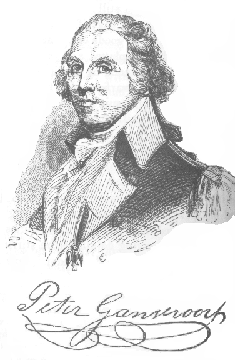|
The
Early Years
Gansevoort grew up in Albany, most likely in the company of the Dutch burgher elite. What occupation he held prewar I do not know at this time. Gansevoort was engaged to (and eventually married) Catherine "Katy" Van Schaick, sister of the 1st NY's Colonel Goose Van Schaick.
 The War Years
The War Years
Gansevoort obtained a lieutenant's commission in a militia company; he desired the prestige of a regular army commission, but was initially turned down. It took the long political arm of Philip Schuyler to get peter a commission as a Major in the Continental Line. Gansevoort served with Montgomery in Canada; he is mentioned in a Willett biography as being present on the Canada campaign--so ill he is brought along on a stretcher. After Montgomery's failed assault on Quebec, Gansevoort received a promotion to Lieutenant Colonel. He assumed command of Fort George at Lake George in June of 1776.
 The third raising of the 3rd New York regiment was led by Peter Gansevoort in 1777. Marinus Willett, ten years Gansevoort's senior, was named as second in command. After the troops were equipped and trained, some did duty on the Hudson River defense line, while other parts of the regiment under Gansevoort were ordered into garrison at Fort Stanwix on the Mohawk River.
The third raising of the 3rd New York regiment was led by Peter Gansevoort in 1777. Marinus Willett, ten years Gansevoort's senior, was named as second in command. After the troops were equipped and trained, some did duty on the Hudson River defense line, while other parts of the regiment under Gansevoort were ordered into garrison at Fort Stanwix on the Mohawk River.
 The Defense of Fort Stanwix
The Defense of Fort Stanwix
The fort, a relic from the French and Indian War, was in sad shape. Gansevoort and Willett immediately took steps to put the works into shape. The need was urgent: Barry St. Leger's force, part of Burgoyne's three pronged offensive, would soon sweep down from Oswego and lay siege to Fort Stanwix. The timing was so tight, that a boat load of provisions was literally rushed in the fort's gates as the British attempted to seize the much needed supplies.
 Gansevoort and Willett made their military reputations during the month long siege of Fort Stanwix. They refused multiple demands of surrender; they raided the enemy camp while most of the hostiles were engaged at Oriskany; Willett slipped out to summon a relief force led by General Benedict Arnold; and, according to legend, they showed their defiance by flying a makeshift version of the Stars and Stripes.
Gansevoort and Willett made their military reputations during the month long siege of Fort Stanwix. They refused multiple demands of surrender; they raided the enemy camp while most of the hostiles were engaged at Oriskany; Willett slipped out to summon a relief force led by General Benedict Arnold; and, according to legend, they showed their defiance by flying a makeshift version of the Stars and Stripes.
 Gansevoort's heroic defense of the Fort was recognized with a promotion to Colonel Commandant of Fort Stanwix. In Europe, this title carried certain perks, but this was not the case in America; Gansevoort complained to his brother Leonard(a New York legislator)that this was not a sufficient reward.
Gansevoort's heroic defense of the Fort was recognized with a promotion to Colonel Commandant of Fort Stanwix. In Europe, this title carried certain perks, but this was not the case in America; Gansevoort complained to his brother Leonard(a New York legislator)that this was not a sufficient reward.
The 3rd NY eventually turned over garrison duties at Stanwix to the 1st NY. Gansevoort's next command was Fort Saratoga(modern Schuylerville).
He continued to lead the 3rd NY during the 1779 Sullivan-Clinton expedition, and led a highly controversial post-campaign raid on a friendly/neutral Iroquois village on the Mohawk.
Gansevoort suffered a relapse of ill health after the campaign, and remained at his home during the winter of 1779-80. He regained his health in the spring; by July, he was with the 3rd NY at West Point. Shortly thereafter, Peter was placed in command of the York Brigade. In the fall, he assumed command of the post at Fort Saratoga. Here he remained until the realignment of the New York Line in 1781,when his position was eliminated. He assumed command of the militia regiments in Albany County as Brigadier General, where he finished out the war.
 Post War
Post War
Gansevoort was especially industrious
in the years following the Revolution. He ran several businesses, including
a sawmill, gristmill, and a farming operation located on the
Snook Kill. This company town eventually came to be named Gansevoort(near
Saratoga Springs). For a political life, he served as the sheriff of Albany
County. He was equally active in his military career; Peter was commissioned
as a Military Agent, performing quartermaster duties. He also was appointed
Brigadier General in the NY State Militia.
Peter was also called on to perform judicial duties for the military. He headed up the court martial of General James Wilkinson, co conspirator of Aaron Burr. Wilkinson actually fared better than Peter at trial's end; he was acquitted, and resumed his life. Peter caught a cold returning home from the trial. This turned into a prolonged sickness that ended with his death on July 2, 1812.
His grandson, Guert Gansevoort, served in the navy, and is also associated with an historic court-martial. Gansevoort was forced into holding the court-martial by his ship's captain. Guert condemned three young sailors to death, one of whom was the Secretary of the Navy's son. This latter event inspired Guert's cousin, Herman Melville, to write Billy Budd.
|

